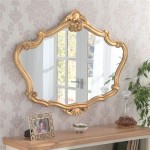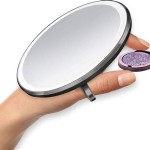Wall Mirror Clips Removal
Removing wall mirror clips can seem daunting, especially when trying to avoid damaging the mirror or the wall. However, with the right tools and techniques, this task can be accomplished safely and efficiently. This article outlines the necessary steps and considerations for removing various types of mirror clips.
Identifying the Clip Type
The first step is identifying the type of clip securing the mirror. Different clip designs require different removal methods. Common types include J-clips, L-clips, spring clips, and decorative clips with concealed fasteners. Closely examine the clip's shape and how it interacts with the mirror and the wall to determine the appropriate approach.
Gathering the Necessary Tools
Having the right tools readily available will streamline the removal process. Commonly required tools include a putty knife, flathead screwdriver, pliers, safety glasses, and work gloves. For stubborn clips, a utility knife or a specialized clip removal tool might be necessary. A pry bar can be helpful, but use it with extreme caution to prevent wall damage. Having a helper to support the mirror during removal is also recommended, particularly for larger or heavier mirrors.
Protecting the Mirror and Wall
Before beginning the removal process, protect both the mirror and the wall from potential damage. Masking tape can help safeguard the mirror's edges and the surrounding wall area. A drop cloth placed beneath the mirror will catch any falling debris and protect the flooring. For larger mirrors, consider using suction cups to provide additional support and control during the removal process.
Removing J-Clips
J-clips are often secured by sliding onto a mounting bracket. To remove them, carefully insert a putty knife or flathead screwdriver between the clip and the wall. Gently pry the clip upwards, disengaging it from the bracket. Work gradually and avoid excessive force, which could damage the mirror or the wall. If the clip is resistant, try using a specialized J-clip removal tool.
Removing L-Clips
L-clips typically have a lip that hooks onto the mirror's edge and is secured to the wall with screws. First, locate and remove the screws holding the clip to the wall using an appropriately sized screwdriver. Once the screws are removed, carefully lift the clip away from the mirror. For stubborn clips, gently pry the lip away from the mirror’s edge with a putty knife, taking care not to scratch the mirror surface.
Removing Spring Clips
Spring clips exert pressure to hold the mirror against the wall. These clips often have a small release mechanism, typically a tab or a small button. Locate this release mechanism and depress it while gently pulling the clip away from the mirror. If the release mechanism is difficult to access, try using needle-nose pliers to depress it. If the clip is particularly tight, a small flathead screwdriver can assist in prying it loose, exercising caution to avoid damage.
Removing Decorative or Concealed Clips
Decorative or concealed clips often have hidden fasteners or intricate designs. Carefully examine the clip to identify any visible screws or release mechanisms. If screws are present, remove them with the appropriate screwdriver. For clips with concealed fasteners, consult the manufacturer's instructions or look for online resources specific to the clip model. A utility knife can sometimes be used to carefully pry open or separate sections of the clip, but this should be done with extreme caution to avoid damage.
Dealing with Stubborn Clips
If a clip is particularly stubborn and doesn't readily release, apply penetrating oil to the contact points between the clip and the wall or mirror. Allow the oil to penetrate for a few minutes before attempting removal again. Avoid using excessive force, as this can damage the mirror or the wall. If the clip remains stuck, consult a professional glazier or handyman for assistance.
Post-Removal Cleanup
Once the clips are removed, inspect the wall for any remaining adhesive or residue. This can be removed with a suitable adhesive remover, following the manufacturer’s instructions. Fill any small holes left by screws with spackle and repaint as needed. Clean the back of the mirror with a glass cleaner to remove any remaining adhesive or debris before remounting or storing the mirror.

2 Step Guide How To Remove A Bathroom Mirror With Clips

Taking Down A Bathroom Mirror

Removing A Bathroom Mirror Mounting Clips Or Brackets

How To Frame A Mirror With Clips In 5 Easy Steps

Diy Bathroom Mirror Frame Without Removing Clips Her Happy Home

How To Safely And Easily Remove A Large Bathroom Builder Mirror From The Wall Site Title

How To Frame A Bathroom Mirror Over Plastic Clips Somewhat Simple

How To Safely And Easily Remove A Large Bathroom Builder Mirror From The Wall Site Title

How To Remove A Bathroom Mirror Lowe S

Diy Bathroom Mirror Frame Without Removing Clips Her Happy Home








